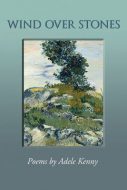 Adele Kenny
Adele Kenny
Wind Over Stones
Welcome Rain Publishers
Reviewer: Vivian Wagner
Wind Over Stones is a remarkable collection of ekphrastic prose poems by Adele Kenny exploring mortality, loss, and joy. At the bottom of each poem’s page there’s a QR code leading to the artwork that inspired the poem, and this design proves a creative method of weaving together the written word and visual imagery, keeping the reader actively engaged in the process of exploring the art in the context of the poems. Because the paintings are not right there on the page, readers might tend first to focus on the poem and then look up the painting, and this flow slows down and enrichens the reading process.
Woven into all of these poems is a narrative of personal growth and transformation. The poems explore the ways in which art is a way to understand our own lives and emotions. Often the speaker in these poems remembers moments from her life in the context of a painting, and the poems draw forth the echoes and resemblances between the words and the imagery. As with the best ekphrastic poetry, the poems don’t simply describe the art that inspired them; rather, they use it as a jumping-off point, a place from which to make sense of one’s life.
The QR codes, as little black-and-white portals on the bottom of each page, are a kind of art themselves. They speak of secrecy and translation, and of the way in which there’s never a one-to-one correspondence between a work of art and our responses to it. The process is always more convoluted and unpredictable, and somehow having to hold one’s smartphone up to the code, find the link, and then follow it embodies that process itself.
Wind Over Stones includes the following epigraph from Simonides: “Painting is silent poetry, and poetry is painting that speaks.” This quote captures one of the themes of the book—that art and poetry are intertwined, and that each can speak what the other cannot. It’s through their interaction, in fact, that either can speak at all.
The book’s divided into three sections that correspond roughly with birth and early life, mid-life, and later life and death. Together, the sections trace the arc of human existence. These are poems about the way we can and must live in the face of a deep understanding of mortality. They’re infused with loss and grief, as well as a celebration of the ways in which loss and grief can be endured and overcome through art.
The first poem in the collection, “Evening as Footnote,” responds to Edward Hopper’s 1921 work Evening Wind. It’s an etching representing a woman on a bed with wind coming through an open window and blowing a curtain inward. The poem responds to the artwork by exploring the feeling of loss and emptiness that it creates: “Evening as footnote after the long day’s rain: unfolded curtains move in and out of the window—second wing of the same dream—one bird, the sky otherwise empty.” The image of the curtain being one wing of a bird expresses something of the poem’s understanding of presence and absence: “When you stand and look up, the night sky fills with memories of stars no longer there, and a voice (just over your shoulder) asks, Where are you?”
The collection’s second poem “How Things Were” also addresses the theme of loss. Inspired by Pieter Brueghel the Elder’s 1560 painting Children’s Games, the poem explores the games played by children and what these games say about the adult culture in which they’re played. As the poem expresses at its beginning, “It’s about the wonder of what we thought, and something about not paying attention because we didn’t have to—it’s about how things changed.” The poem focuses on children’s games not from the sixteenth century but from the twentieth, drawing connections between eras and the way in which games illustrate something of the underlying human condition across time: “Post-war children, the only soldiers we understood were green plastic, my cousin Eddie’s army, half of which we tossed into the storm sewer.” The poem ends by tying these games, from century to century, to the mortality that all humans face, but about which children are, for a time, blissfully ignorant: “As far as we knew, there was no end of the world, no end of anything—life was nothing more than how things were—our innocence an amulet, a green plastic soldier, that kept us safe.”
The poems in the second section explore what it means to live in the middle of a life, balancing the demands and concerns of adulthood. The first poem in this section, “For a Moment, Like Stones,” responds to Pierre-August Renoir’s 1882 painting The Wave. The painting itself is an impressionistic portrait of a wave, dominated by whites and blues and capturing the force and chaotic power of water. The poem takes that painting, with its emphasis on wildness and unpredictability, as a starting point for exploring those same themes in a human life: “Terrified or indifferent, having taken enough chances—all things at once (and then, regret)—it’s easy to forget what we’re here for (easy to become like every unreadable thing and the moon that has no light of its own). There are no equivalents, only what falls by accident or master plan.”
Like the painting, the speaker’s life has no master plan; it is, rather, a series of unplanned occurrences that stitch themselves together into something that perhaps only seems, in retrospect, coherent. As the poet says, “Transients here, awkward and sad, we trust in mysteries and barely know ourselves. Like Icarus, we create whatever flight we can, glimpse our shadows on the wave below and float … for a moment, like stones.”
The theme of stones and rocks and their role in mortality is a recurring one, as suggested by the collection’s title and the last poem of the collection, “Like Wind Over Stones,” which takes its inspiration from Vincent van Gogh’s 1888 painting The Rocks. In the painting, a craggy oak tree is rooted into a hillside among rocks, themselves craggy and carved by eons of erosion (erosion is, ultimately, at the heart of Kenny’s interest in stones). Though they seem stable and solid, they are, in fact, being continually eroded, albeit at a somewhat slower clip than humans themselves.
This poem explores the theme of loss and the way in which loss often opens into a new and transformed future. As the poem’s final section says, “Some things are easily remembered (resonant, indelible)—others, more fragile but equally blessed, are best understood by their loss. We have let ourselves be known slowly—beginning, being. So many years from where we were, we have spoken the word open.” Even in the face of fragility, loss, and erosion, we find ourselves coming to understand openness. The future might not be ours, exactly, but it’s there, speaking always of possibility and change.
All of the poems in Wind Over Stones explore, on some level, how we come to terms with mortality and still manage to create fulfilling and happy lives. The poems, in their interactions with the complementary paintings, examine and describe the way life is a not a fixed or predictable story, but rather a near-infinite series of moments simultaneously informed by both grief and joy.

